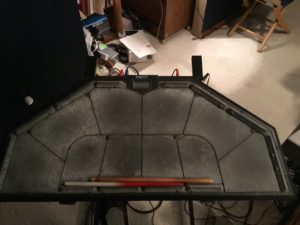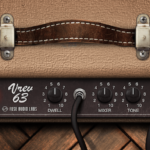Sometime in the early 90s, I tried out an electric drum kit at a Columbus music store. I forget what brand it was – probably an early Roland model. I was surprised at the feel. While not as sensitive or dynamic as a real kit – I owned a Pearl 5-piece at the time – it definitely worked for me; even the kick pedal which is usually my biggest issue when playing someone else’s drum set at a multi-band show. I just had to be able to do my John Bonham right foot kick work.
An Early User of Roland Electronic Drums
Fast forward a few years when Quarkspace was first getting off the ground. Our style was a weird mix between psychedelic/proggy jamming, like the Grateful Dead, Floyd, or YES, and more electronic styles, ala the Orb or Orbital. We felt an electronic drum kit would be perfect for us, especially since the lack of loud acoustic drums on stage meant we didn’t need use individual amps, an essential way to limit the onstage sound, enhancing the listening necessary to do quality improvisations.
Additionally, I am a keyboard player and synthesist, so electronic drums and their programmability are perfect for my style of music compared to using a traditional trap kit. I sold the Pearl and never looked back!
I ended up buying a 5-piece Roland electronic drum kit with the TD-5 module. For additional fun, I picked up a used DrumKAT which I placed to the right of the Roland pads. While this setup worked well for the most part, I wasn’t a big fan of the TD-5’s sounds, and the old trap kit metaphor of the pad setup wasn’t to my liking, even with the DrumKAT. There had to be a better way!
Enter the trapKAT
In the late 90s, the newly released Alternate Mode trapKAT seemed like a perfect solution to my electronic percussion needs. Its trapezoid layout featuring both large pads and smaller pads around the rim appealed to me. I also picked up a FatKAT kick pedal and repurposed the virtual hi-hat pedal from my Roland set.
For a sound module, I went for the Roland TD-8, which served as the brain for their new line of V-Drum electronic sets. The V-Drum’s mesh pads and traditional kit layout didn’t appeal to me, in addition to the rather high price. I’ve always been able to control the sounds I wanted using the TD-8, even when using the physical modeling drum sounds in the module.
The trapKAT’s playability has always been top notch, and its action still holds up after two decades of use. The FatKAT allows me to do those Bonham kick drum bits just like an acoustic bass drum. Being able to do cymbal clinches on the rim pads is another great feature.
Two Decades of Electronic Drumming
As I just mentioned, the trapKAT still plays great even after two decades of use – the FatKAT too. Over time I added a Boss VF-1 effects unit dedicated to the TD-8 for additional sonic manipulation. I now also use software plugins as a sound source, since I predominately work in the studio these days. BFD is my favorite, and I just picked up Spitfire Audio’s Hans Zimmer Percussion collection to add to the arsenal (a review is coming.)
I especially enjoy using the TD-8’s TR-808 and TR-909 kits in my projects. They also sound great with the Arturia DrumBrute. My electronic percussion studio needs are in good hands. Although, I’ve been looking at getting a pair of “real” bongos just to get those hands dirty again.
If you are a drummer looking to explore the world of electronic percussion, the trapKAT needs to be on your short list. Don’t let the fact I’m a KAT Featured Artist let you think I’m biased. I’ve used their products for 20 years before I gained that extra moniker.
In short, the trapKAT remains an essential part of my studio setup. When it comes time to lay down a few beats, it’s the perfect option.


[…] an electronic drummer, I continue to hold an affinity for e-percussion products. The new BopPad, from Keith McMillen […]